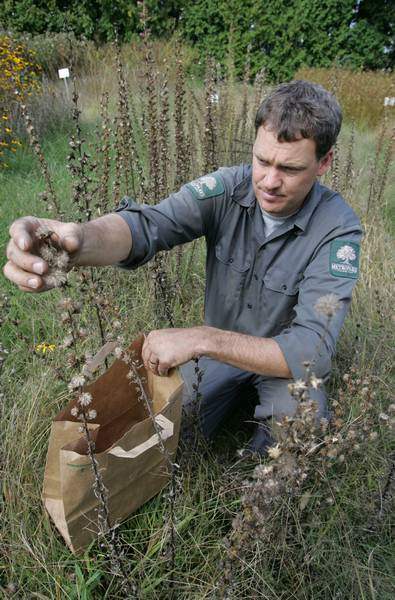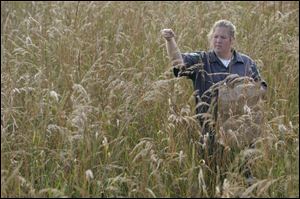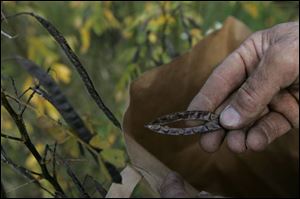
Seed collectors help Metroparks remain in bloom
9/28/2006
Metroparks land management supervisor Tim Gallaher gathers Rough Blazing Star seeds at Blue Creek Metropark.

Penny Wagner looks for Indian grass seeds - at 12,000 to an ounce - at Blue Creek Metropark.
Picking their way through feathery prairie grasses and sticky tangles of weeds, volunteers at Side Cut Metropark today will set out to save this corner of the world one teeny-tiny, itty-bitty piece at a time.
They will be armed with surprisingly low-tech equipment - brown paper bags.
Their target? Seeds. Lots and lots and lots of them.

Metroparks land management supervisor Tim Gallaher gathers Rough Blazing Star seeds at Blue Creek Metropark.
"It's one of those things that anyone can do," said Penny Wagner, land-management coordinator for the Toledo Area Metroparks District, which operates Side Cut Metropark in Maumee and 10 other parks throughout Lucas County. "You don't have to know a single thing about any of [the plants] out here, but still have fun. And if you do know about them well, even better."
Today's seed search party, which sets out at 4 p.m., is the first of about 12 such collections scheduled every autumn throughout the Toledo Area Metroparks.
Like many other park systems, Metroparks relies on the nimble fingers of volunteers to pluck and shuck countless millions of seeds.
If all goes well, the seedlings will be handed over to local schoolchildren who will grow them in classrooms over the winter and return them to the park system for planting.
The effort boosts the number of native plants that take hold in the spring. And that, in turn, ensures their survival against enemies like urban sprawl or even other flora, like the friendly-looking-but-oh-so-invasive honeysuckle.

Wild Senna seeds.
The seed-collecting volunteers come out in force - lucky for the park system.
Consider the tiny seed of the Monkey Flower, or Mimulus ringens. It takes 2.3 million of them to make a single ounce.
Even the Indian grass seed, which is relatively hefty by some seed standards, requires 12,000 to add up to an ounce.
Yet volunteers and staff picked their way to 500 pounds - yes, pounds - of seeds last year. Another 250 pounds was harvested by the park district's converted combine, Ms. Wagner said.
"We've had parents with babies in their packs, and we've had seniors," said Trish Hausknecht, volunteer coordinator for the park system's environmental programs. "It's one of our favorite programs, and people come back again and again."
Perhaps its the sensory explosion that draws them, Ms. Wagner surmised earlier this week as she strolled into the outside "nursery" at Blue Creek Conservation Area.
The whistle and whirr of crickets and the sweet smell of gnaphalium obtusifolium, or Sweet Everlasting, filled the air while clumps of bright purple aster shifted in the wind.
"It's a great time to be out here," she said.
There might be another reason that volunteers seem to like the seed gathering, says Laurel Malvitz, a resource steward for Michigan's Department of Natural Resources, which holds a seed gathering event at Monroe County's Sterling State Park.
Seed collection is a reprieve from the constant battle against the pesky buckthorn and autumn olive shrubs or the ever-spreading garlic mustard.
"In a lot of other activities we do throughout the year, we're combatting invasive species," Ms. Malvitz said.
In seed gathering, "We're giving people a very positive feeling," she said.
Contact Robin Erb at: robinerb@theblade.com or 419-724-6133.